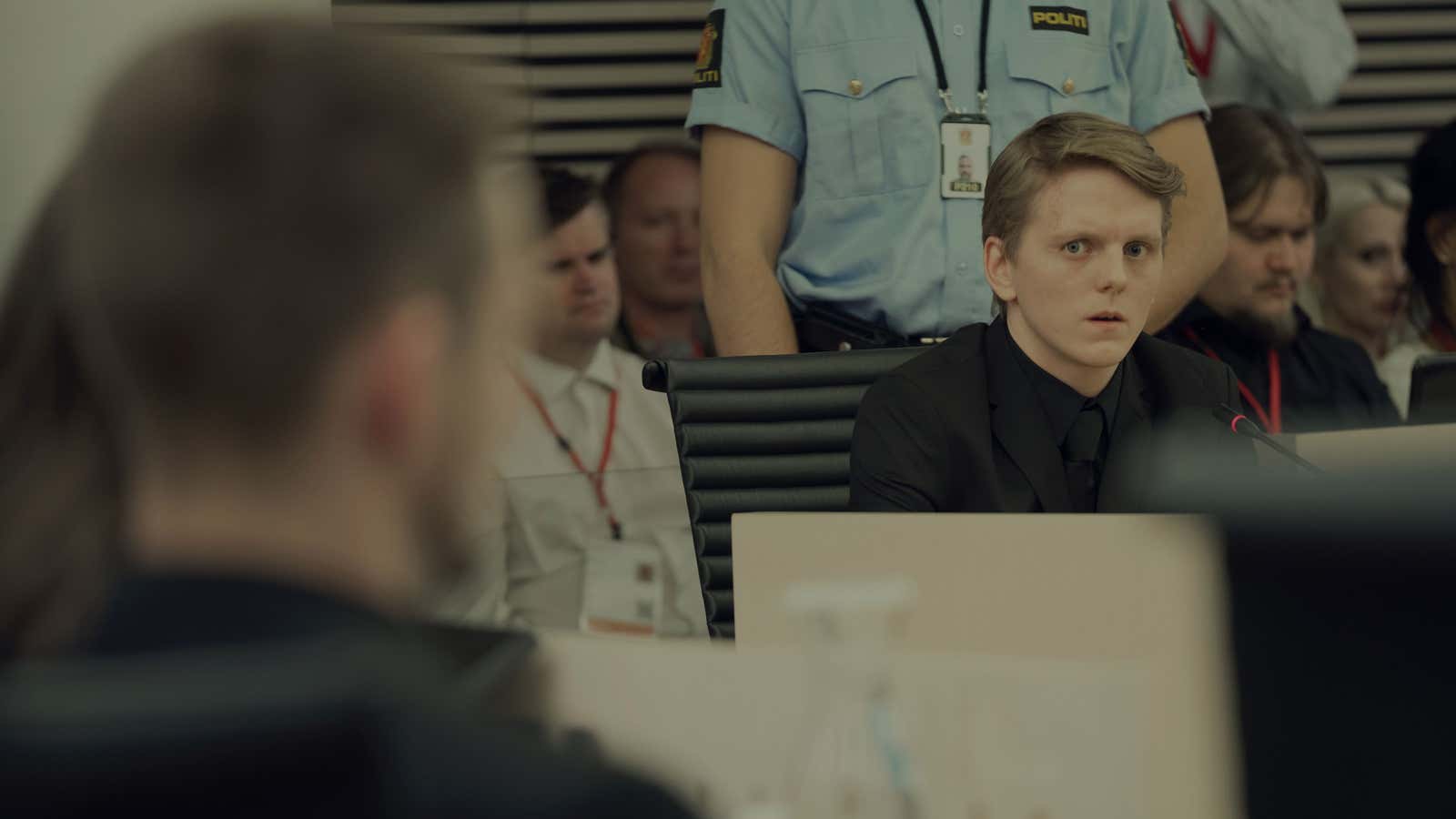He wants an end to “enforced multiculturalism.” He wants to ban immigration. He despises leftists and “children of the elite.” No, this isn’t the latest screed of Trump advisor Stephen Miller, nor one of many unhinged Tucker Carlson rants on Fox News—though it could be either.
These are the real words of Anders Behring Breivik, a far-right terrorist who murdered 77 people, mostly teenagers, in a bombing and shooting rampage in Norway in 2011. The attacks and their aftermath are depicted in the new Netflix film 22 July, directed by the British filmmaker Paul Greengrass and featuring an all-Norwegian cast and crew.
As an examination of the horrific 2011 attacks, 22 July is a messy film that fluctuates somewhere between restraint and tastelessness, grace and inelegance. Some will be immediately turned off by it. Others, moved. And plenty will question the choice of having the Norwegian actors speak in English, which arguably takes some of the soul out of the performances.
But it’s clear about halfway through the film why it needed to be an English: 22 July isn’t only about a terrorist attack in Norway seven years ago. It’s about the entire world, right now, and it’s a film that demands to be seen in several English-speaking countries that, in recent years, have shown themselves to be extremely susceptible to certain fundamentals of Breivik’s hateful worldview.
On July 22, 2011, Breivik detonated a homemade bomb outside the offices of prime minister Jens Stoltenberg in Oslo, killing eight people and injuring more than 200 others. Then, posing as a police officer, he took a ferry to the island of Utøya, which housed a summer camp for the youth division of the country’s center-left Labour party, where he killed 69 more with a semi-automatic rifle. He eventually surrendered to police.
Greengrass spares viewers a drawn-out depiction of the attacks. The scene on Utøya, as horrific and uncompromising as it is, lasts only about 15 minutes. The majority of the film focuses on the aftermath of the attacks, including Breivik’s trial, the survivors’ grueling mental and physical rehabilitation, and Norway’s struggle to move forward following its worst atrocity since World War II.
Anders Danielsen Lie portrays Breivik as chillingly sane. There are no questions about whether or not he was in control of his faculties, no efforts to paint the terrorist as just some bullied outcast who finally snapped. He is completely aware of what he did and unambiguous about why he did it. Breivik’s only regret is that he did not kill more.
His lawyers nevertheless decide to mount an insanity defense, but they know as well as anyone that Breivik, in terms of criminal liability, is a sane person—one with a heinous worldview, empowered by access to high-powered assault weapons.
Court-appointed psychiatrists initially diagnose Breivik with paranoid schizophrenia and claim that he was psychotic during and after the attacks. The diagnosis is disputed by pretty much every mental health expert in Norway, as well as by Breivik himself, who’s insulted by the suggestion that he didn’t know what he was doing. He insists that the world knows these attacks were carried out by a sane person with a very specific mission: to instigate a war. “Many in the coming decades will realize this and pick up arms just as I did,” he says. A second psychiatric examination is ordered that concludes Breivik has narcissistic personality disorder, but was not at all psychotic at any point during or after the attacks.
Breivik claims he has “millions” of supporters and is some kind of celebrity in Europe’s far-right movement, but his defense team can’t locate a single witness to vouch for him. The only person his lawyers can convince to testify during the trial is a man Breivik once “met” on an online World of Warcraft forum, and he proceeds to immediately undermine the terrorist’s argument that he’s anything other than a disturbed lone wolf.
Although Breivik may have planned his attacks alone, some of his abominable political ideas were indeed shared by people in Norway and throughout Europe at the time, and have only proliferated since. Greengrass has no qualms about diving right into righteous didacticism, as if there were any other choice with a film like this. 22 July isn’t a gentle reminder. It’s not even a warning—we’re long past that. It’s more of an alarm bell.
“[Breivik] talks about the betrayal by the elites, the sham of democracy, enforced multiculturalism,” Greengrass told the Atlantic. “Those opinions in 2011, 2012, would have been considered on the margins of discourse. Today, what he said, that’s mainstream now, that’s populist right-wing rhetoric. I’ve no doubt that Steve Bannon would abhor Breivik’s methods. The point is the worldview, the intellectual framework, if you can call it that, is the same and it has moved into the mainstream.” (As if to confirm his point, Breitbart News has called 22 July “leftist agitprop.”)
That these ideas have moved into the mainstream in recent years in the US and the UK is indisputable. Since the attacks, the UK voted to leave the European Union after a propaganda campaign stoked fears of immigration. The US elected a president who promptly banned travel to the US from Muslim-majority countries, forcibly separated children from their families at the US-Mexico border, and promised to literally wall the country off from the outside world. A white supremacist murdered nine people inside a black church in Charleston, South Carolina. A neo-Nazi in Charlottesville, Virginia rammed his car through a group of peaceful counter-protestors, killing one woman and injuring 19 others.
And Greengrass might actually be downplaying the popularity of these hateful ideas even as far back as 2011. Breivik’s manifesto cited the anti-Islamic conservative commentator Pamela Gellar, who’s been a regular guest on Fox News. He also references works by the notorious Islamophobe and frequent Fox News guest Robert Spencer. Breivik didn’t come up with this stuff by himself. Nor did he find it in only the darkest corners of the internet.
And yet, Greengrass manages to avoid turning the film into an utterly dire, hopeless watch. It’s devastating, to be sure, but not defeatist. There is a way forward, Greengrass argues. The beating heart of the film is in the survivors, especially a bright-eyed 18-year-old named Viljar Hanssen, played by Jonas Strand Gravli. Viljar is shot five times during the attack and survives, but loses vision in his right eye due to a head wound that leaves several bullet fragments implanted near his brain stem. He also loses something else—his optimism, his will to do good, to keep dreaming.
With the help of his friends and family, he is eventually able to confront the man who tried to kill him, who succeeded in killing so many others. And that’s when Viljar looks across the court room at Breivik and realizes that losing his will is exactly what the terrorist wants.
Viljar looks his attacker in the eye and tells him that he will waste away in a prison cell for the rest of his life—effectively if not literally dead and gone. Viljar, however, will choose to live. The real-life Viljar Hanssen, now 25, intends to fight far-right extremism as a politician in Norway.

